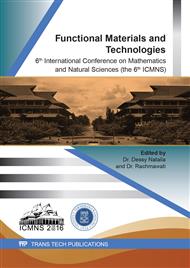p.3
p.8
p.14
p.22
p.28
p.34
p.40
p.47
The Synthesis of Polyethersulfone (PES) Derivatives for the Immobilization of Lipase Enzyme
Abstract:
Nowadays the development of biodiesel production as an alternative renewable energy became crucial. The reusability of enzymes as biocatalysts in biodiesel production has limitations and can be improved by the immobilization process onto the appropriate solid support, such as polyethersulfone (PES). Polyethersulfone has been synthesized utilizing microwave-assisted reaction method (400 W, 170 °C, 60 minutes). Nitration reaction of PES was performed by refluxing the synthesized PES with the mixtures of H2SO4 (0 °C, ± 30 minutes) and HNO3 (25 °C, 4 hours). The –NO2 groups of the synthesized PES-NO2 was subsequently reduced to be PES-NH2 using SnCl2.2H2O as reducing agent by reflux method (60 °C, ± 3 hours). The structure of PES and its derivatives was confirmed by FTIR and 1H-NMR. Candida antarctica lipase was successfully immobilized onto the synthesized PES and its derivatives, which were confirmed by its FTIR spectra and its activity tests of the supernatants in hydrolyzing p-nitrophenol palmitate (pNPP) into p-nitrophenol (pNP). The results showed that the conversion percentage of pNPP to become pNP were 20.6% (free enzyme), 18.9% (PES-enzyme), and 3.7% (PES-NH2-enzyme). The decrease in the supernatant enzyme activity showed that the enzyme has been successfully immobilized through physical adsorption onto the synthesized polymers.
Info:
Periodical:
Pages:
14-21
Citation:
Online since:
July 2019
Authors:
Keywords:
Price:
Сopyright:
© 2019 Trans Tech Publications Ltd. All Rights Reserved
Share:
Citation:



